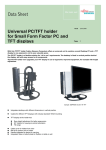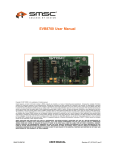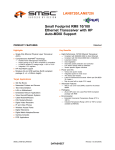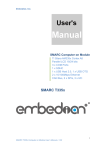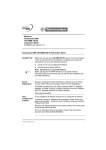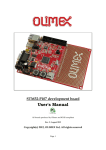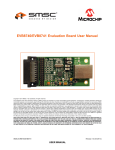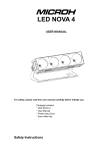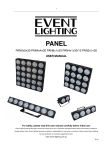Download EVB8700 Evaluation Board User Manual
Transcript
EVB8700 Evaluation Board User Manual Copyright © 2010 SMSC or its subsidiaries. All rights reserved. Circuit diagrams and other information relating to SMSC products are included as a means of illustrating typical applications. Consequently, complete information sufficient for construction purposes is not necessarily given. Although the information has been checked and is believed to be accurate, no responsibility is assumed for inaccuracies. SMSC reserves the right to make changes to specifications and product descriptions at any time without notice. Contact your local SMSC sales office to obtain the latest specifications before placing your product order. The provision of this information does not convey to the purchaser of the described semiconductor devices any licenses under any patent rights or other intellectual property rights of SMSC or others. All sales are expressly conditional on your agreement to the terms and conditions of the most recently dated version of SMSC's standard Terms of Sale Agreement dated before the date of your order (the "Terms of Sale Agreement"). The product may contain design defects or errors known as anomalies which may cause the product's functions to deviate from published specifications. Anomaly sheets are available upon request. SMSC products are not designed, intended, authorized or warranted for use in any life support or other application where product failure could cause or contribute to personal injury or severe property damage. Any and all such uses without prior written approval of an Officer of SMSC and further testing and/or modification will be fully at the risk of the customer. Copies of this document or other SMSC literature, as well as the Terms of Sale Agreement, may be obtained by visiting SMSC’s website at http://www.smsc.com. SMSC is a registered trademark of Standard Microsystems Corporation (“SMSC”). Product names and company names are the trademarks of their respective holders. SMSC DISCLAIMS AND EXCLUDES ANY AND ALL WARRANTIES, INCLUDING WITHOUT LIMITATION ANY AND ALL IMPLIED WARRANTIES OF MERCHANTABILITY, FITNESS FOR A PARTICULAR PURPOSE, TITLE, AND AGAINST INFRINGEMENT AND THE LIKE, AND ANY AND ALL WARRANTIES ARISING FROM ANY COURSE OF DEALING OR USAGE OF TRADE. IN NO EVENT SHALL SMSC BE LIABLE FOR ANY DIRECT, INCIDENTAL, INDIRECT, SPECIAL, PUNITIVE, OR CONSEQUENTIAL DAMAGES; OR FOR LOST DATA, PROFITS, SAVINGS OR REVENUES OF ANY KIND; REGARDLESS OF THE FORM OF ACTION, WHETHER BASED ON CONTRACT; TORT; NEGLIGENCE OF SMSC OR OTHERS; STRICT LIABILITY; BREACH OF WARRANTY; OR OTHERWISE; WHETHER OR NOT ANY REMEDY OF BUYER IS HELD TO HAVE FAILED OF ITS ESSENTIAL PURPOSE, AND WHETHER OR NOT SMSC HAS BEEN ADVISED OF THE POSSIBILITY OF SUCH DAMAGES. SMSC LAN8700 USER MANUAL Revision 1.0 (02-23-10) LAN8700 Evaluation Board User Manual 1 Introduction The SMSC LAN8700 is a low-power, variable I/O voltage, analog interface IC with HP Auto-MDIX support for high-performance embedded Ethernet applications. The LAN8700 consists of an encoder/decoder, scrambler/descrambler, wave-shaping transmitter, output driver, twisted-pair receiver with adaptive equalizer and baseline wander (BLW) correction, and clock and data recovery functions. The EVB8700 is an Evaluation Board (EVB) that interfaces a standard 40-pin female MII connector from an existing MAC controller to the SMSC LAN8700 Ethernet PHY, and out to an RJ45 Ethernet Jack for 10/100 connectivity. A simplified block diagram of the EVB8700 can be seen in Figure 1.1. Ethernet 10/100 Ethernet Magnetics RJ45 SMSC LAN8700 MII Bus 40-pin Connector MII EVB8700 Figure 1.1 EVB8700 Block Diagram 1.1 References Concepts and material available in the following documents may be helpful when using the EVB8700. Table 1.1 References DOCUMENT LOCATION SMSC LAN8700 Datasheet http://www.smsc.com/lan8700 SMSC EVB8700 Evaluation Board Schematic http://www.smsc.com/lan8700 AN16-12 LAN8700 User Application and Configuration Guide http://www.smsc.com/lan8700 AN8-13 Suggested Magnetics http://www.smsc.com/lan8700 Revision 1.0 (02-23-10) USER MANUAL 2 SMSC LAN8700 LAN8700 Evaluation Board User Manual 2 Board Details This section includes the following EVB8700 board details: 2.1 Power Configuration Mechanicals Power Power is normally supplied to the EVB8700’s +3.3V regulator externally via the +5V power pins of the MII connector. If desired, the EVB8700 can be powered without +5V present on the MII connector by supplying +5V to the TP2 test point with ground connected to pin 20 of header J2. Note: Before connecting an external power supply to TP2, ensure power is not present on the MII connector’s +5V pins. Connecting +5V simultaneously via the MII connector and TP2 may result in permanent damage to the board. 2.2 Configuration The following sub-sections describe the various board features and configuration settings. A top view of the EVB8700 is shown in Figure 2.1. Ethernet Port (integrated LEDs) LED1 LED2 TP3 TP2 +3.3V +5V LAN8700 Reset Switch MII Testpoints Female MII Connector Figure 2.1 EVB8700 Top View Note: Though the LAN8700 supports an RMII mode of operation and/or use of an external +1.8V regulator, the EVB8700 does not support these modes. SMSC LAN8700 USER MANUAL 3 Revision 1.0 (02-23-10) LAN8700 Evaluation Board User Manual 2.2.1 PHY Address and LED Configuration The LAN8700 allows the user to configure the default PHY address at power-up via the PHYAD[4:0] configuration straps. Because these straps share functionality with device LEDs, care must be taken to properly configure these signals. Table 2.1 details the proper configuration required for each PHY address value. By default, all EVB8700 PHY address straps are configured to a value of “1”. Note: The PHYAD1 and PHYAD2 LEDs may function active-high or active-low depending on the boards PHY address configuration. Refer to Table 2.1 and the LAN8700 Datasheet for additional information. Table 2.1 PHY Address Configuration Settings “0” “1” (DEFAULT) PHYAD4 (MSB) R11 populated R11 unpopulated PHYAD3 R46 unpopulated R48 populated R36 populated LED2 anode connected to FDUPLEX pin (flipped) R46 populated R48 unpopulated R36 unpopulated LED2 cathode connected to FDUPLEX pin R2 populated in position 2-3 R1 populated in position 2-3 R35 populated R2 populated in position 1-2 R1 populated in position 1-2 R35 unpopulated Note: Note: PHYAD2 PHYAD1 PHYAD0 (LSB) RJ45 Yellow LED will be active-high RJ45 Yellow LED will be active-low R3 populated in position 2-3 R4 populated in position 2-3 R34 populated R3 populated in position 1-2 R4 populated in position 1-2 R34 unpopulated Note: Note: RJ45 Green LED will be active-high R45 unpopulated R47 populated R33 populated LED1 anode connected to SPEED100 pin (flipped) RJ45 Green LED will be active-low R45 populated R47 unpopulated R33 unpopulated LED1 cathode connected to SPEED100 pin LED reference designators and definitions are detailed in Table 2.2. Table 2.2 LEDs REFERENCE COLOR INDICATION Green Ethernet Link Yellow Ethernet Activity LED1 Green Ethernet Speed LED2 Green Ethernet Full-Duplex J1 Revision 1.0 (02-23-10) USER MANUAL 4 SMSC LAN8700 LAN8700 Evaluation Board User Manual 2.2.2 Boot Mode Configuration The LAN8700 can be configured to boot into a specific mode of operation at power-up via the MODE[2:0] configuration straps. By default, the MODE[2:0] configuration straps are pulled-up internally to “1”. Unpopulated pull-down resistor pads are provided for each MODE[2:0] configuration strap. These pull-down resistors should only be populated when the corresponding MODE[2:0] configuration strap is desired to default to “0”. A list of the LAN8700 modes and their corresponding pull-down resistor configurations are shown in Table 2.3. Table 2.3 MODE[2:0] Resistor Configuration MODE[2:0] PULL-DOWN RESISTORS MODE[2:0] MODE DEFINITIONS R40 (MODE2) R41 (MODE1) R42 (MODE0) 000 10BASE-T Half Duplex Auto-negotiation disabled Populated Populated Populated 001 10BASE-T Full Duplex Auto-negotiation disabled. Populated Populated Unpopulated 010 100BASE-TX Half Duplex Auto-negotiation disabled CRS is active during Transmit & Receive Populated Unpopulated Populated 011 100BASE-TX Full Duplex Auto-negotiation disabled CRS is active during Receive Populated Unpopulated Unpopulated 100 100BASE-TX Half Duplex is advertised Auto-negotiation enabled. CRS is active during Transmit & Receive. Unpopulated Populated Populated 101 Repeater mode (Note 2.1) Auto-negotiation enabled 100BASE-TX Half Duplex is advertised CRS is active during receive Unpopulated Populated Unpopulated 110 Power Down mode (Note 2.2) Unpopulated Unpopulated Populated 111 All capable. Auto-negotiation enabled (Default) Unpopulated Unpopulated Unpopulated Note 2.1 Refer to the LAN8700 Datasheet for additional information on Repeater mode. Note 2.2 Refer to the LAN8700 Datasheet for additional information on Power-Down mode. SMSC LAN8700 USER MANUAL 5 Revision 1.0 (02-23-10) LAN8700 Evaluation Board User Manual 2.2.3 nINT/TX_ER/TXD4 Pin Configuration The nINT, TX_ER, and TXD4 functions share a common LAN8700 pin. This pin can operate in two functional modes: nINT (Interrupt) Mode and TX_ER/TXD4 Mode. The RXD3/nINTSEL pin is used to select one of these two modes. The EVB8700 must be properly configured for each mode as follows: nINT Mode (Default EVB8700 Mode) The nINTSEL configuration strap is pulled-up internally (by default) to select nINT mode. (R39 unpopulated) R52 must be in the 1-2 position, which routes nINT to pin 21 of the J2 MII header TX_ER/TXD4 Mode The nINTSEL configuration strap is pulled-down to select TX_ER/TXD4 mode. (R39 populated) R52 must be in the 2-3 position, which routes TX_ER/TXD4 to pin 11 of the J2 MII header For additional information on the functionality of the nINT/TX_ER/TXD4 pin, refer to the LAN8700 Datasheet and EVB8700 schematics. 2.2.4 Test Points Table 2.4 Test Points TEST POINT DESCRIPTION CONNECTION TP2 +5V Test Point (Unpopulated) (Note 2.3) +5V TP3 +3.3V Test Point (Unpopulated) +3.3V Note 2.3 2.2.5 Test point TP2 can be used as an alternative source of +5V to the EVB8700. Refer to Section 2.1, "Power," on page 3 for additional information. System Connections Table 2.5 System Connections PLUG/HEADER J1 J2 DESCRIPTION PART RJ45 with Integrated LEDs Amphenol RJSBE5381C1 2x14 MII Header Note: Refer Table 2.6 to for a full pin list Adam Tech PH2-28-U-A 40-pin Female MII Connector P1 Revision 1.0 (02-23-10) Note: This connector follows the standardized MII pinout. Refer to the EVB8700 schematic for additional information. (Note 2.4) USER MANUAL 6 Tyco 5173278-2 SMSC LAN8700 LAN8700 Evaluation Board User Manual Table 2.6 J2 - 2x14 MII Header Pinout HEADER PIN HEADER PIN DESCRIPTION DESCRIPTION 1 Ground 15 TXD1 2 MDIO (Note 2.4) 16 TXD2 3 MDC 17 TXD3 4 RXD3/nINTSEL 18 COL/MII/CRS_DV 5 RXD2/MODE2 19 CRS/PHYAD4 6 RXD1/MODE1 20 Ground 7 RXD0/MODE0 21 nINT (Note 2.5) 8 RX_DV 22 +3.3V 9 RX_CLK/REGOFF 23 +3.3V 10 RX_ER/RXD4 24 Ground 11 TX_ER/TXD4 (Note 2.5) 25 +5V 12 TX_CLK 26 Ground 13 TX_EN 27 +5V 14 TXD0 28 Ground 2.2.6 Note 2.4 Resistor R12 acts as a pull-up on the MDIO pin. In most situations, the MAC circuitry provides this pull-up and R12 is not required. Note 2.5 Pins 11 and 21 of the J2 header both connect to resistor R52. This resistor must be positioned correctly in order to divert the nINT/TX_ER/TXD4 pin of the LAN8700 to the correct J2 location, as determined by the nINTSEL configuration strap value. Refer to Section 2.2.3, "nINT/TX_ER/TXD4 Pin Configuration," on page 6 for additional information. Switches Table 2.7 Switches SWITCH S1 SMSC LAN8700 DESCRIPTION FUNCTION Reset switch When pressed, triggers a board reset USER MANUAL 7 Revision 1.0 (02-23-10) LAN8700 Evaluation Board User Manual 2.3 Mechanicals Figure 2.2 details the EVB8700 mechanical dimensions. 0.255 0.175 1.750 Ø0.125 TOP VIEW Ø0.125 0.175 0.255 3.530 Figure 2.2 EVB8700 Mechanicals Revision 1.0 (02-23-10) USER MANUAL 8 SMSC LAN8700 LAN8700 Evaluation Board User Manual 3 User Manual Revision History Table 3.1 Revision History REVISION LEVEL & DATE Rev. 1.0 (02-23-10) SMSC LAN8700 SECTION/FIGURE/ENTRY CORRECTION Initial Release USER MANUAL 9 Revision 1.0 (02-23-10)









